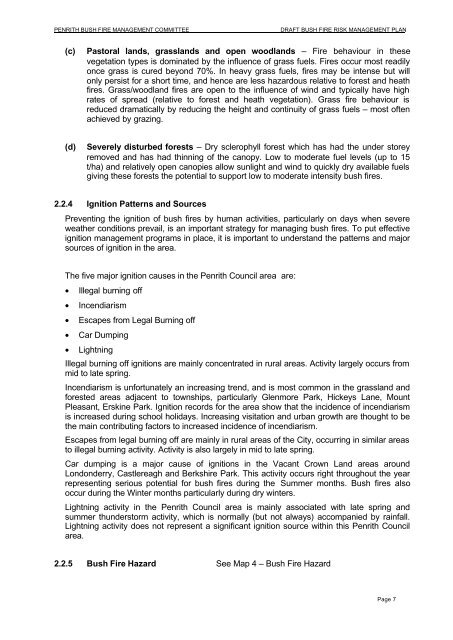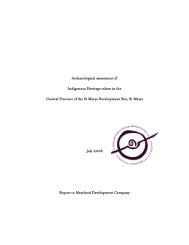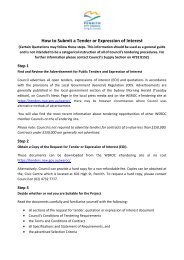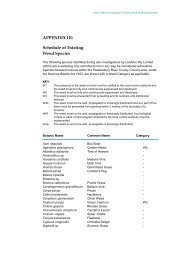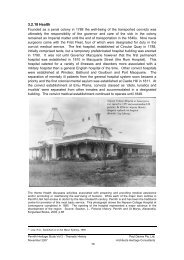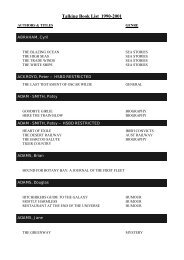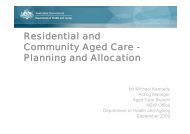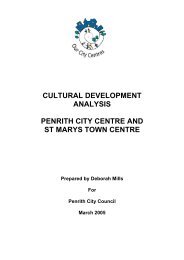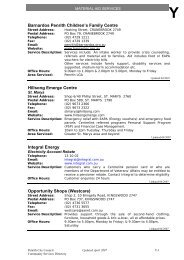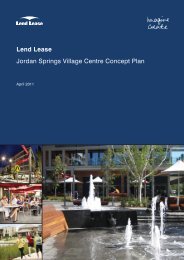Penrith Bush Fire Management Committee Bush Fire Risk ...
Penrith Bush Fire Management Committee Bush Fire Risk ...
Penrith Bush Fire Management Committee Bush Fire Risk ...
Create successful ePaper yourself
Turn your PDF publications into a flip-book with our unique Google optimized e-Paper software.
PENRITH BUSH FIRE MANAGEMENT COMMITTEE DRAFT BUSH FIRE RISK MANAGEMENT PLAN<br />
(c) Pastoral lands, grasslands and open woodlands – <strong>Fire</strong> behaviour in these<br />
vegetation types is dominated by the influence of grass fuels. <strong>Fire</strong>s occur most readily<br />
once grass is cured beyond 70%. In heavy grass fuels, fires may be intense but will<br />
only persist for a short time, and hence are less hazardous relative to forest and heath<br />
fires. Grass/woodland fires are open to the influence of wind and typically have high<br />
rates of spread (relative to forest and heath vegetation). Grass fire behaviour is<br />
reduced dramatically by reducing the height and continuity of grass fuels – most often<br />
achieved by grazing.<br />
(d) Severely disturbed forests – Dry sclerophyll forest which has had the under storey<br />
removed and has had thinning of the canopy. Low to moderate fuel levels (up to 15<br />
t/ha) and relatively open canopies allow sunlight and wind to quickly dry available fuels<br />
giving these forests the potential to support low to moderate intensity bush fires.<br />
2.2.4 Ignition Patterns and Sources<br />
Preventing the ignition of bush fires by human activities, particularly on days when severe<br />
weather conditions prevail, is an important strategy for managing bush fires. To put effective<br />
ignition management programs in place, it is important to understand the patterns and major<br />
sources of ignition in the area.<br />
The five major ignition causes in the <strong>Penrith</strong> Council area are:<br />
• Illegal burning off<br />
• Incendiarism<br />
• Escapes from Legal Burning off<br />
• Car Dumping<br />
• Lightning<br />
Illegal burning off ignitions are mainly concentrated in rural areas. Activity largely occurs from<br />
mid to late spring.<br />
Incendiarism is unfortunately an increasing trend, and is most common in the grassland and<br />
forested areas adjacent to townships, particularly Glenmore Park, Hickeys Lane, Mount<br />
Pleasant, Erskine Park. Ignition records for the area show that the incidence of incendiarism<br />
is increased during school holidays. Increasing visitation and urban growth are thought to be<br />
the main contributing factors to increased incidence of incendiarism.<br />
Escapes from legal burning off are mainly in rural areas of the City, occurring in similar areas<br />
to illegal burning activity. Activity is also largely in mid to late spring.<br />
Car dumping is a major cause of ignitions in the Vacant Crown Land areas around<br />
Londonderry, Castlereagh and Berkshire Park. This activity occurs right throughout the year<br />
representing serious potential for bush fires during the Summer months. <strong>Bush</strong> fires also<br />
occur during the Winter months particularly during dry winters.<br />
Lightning activity in the <strong>Penrith</strong> Council area is mainly associated with late spring and<br />
summer thunderstorm activity, which is normally (but not always) accompanied by rainfall.<br />
Lightning activity does not represent a significant ignition source within this <strong>Penrith</strong> Council<br />
area.<br />
2.2.5 <strong>Bush</strong> <strong>Fire</strong> Hazard See Map 4 – <strong>Bush</strong> <strong>Fire</strong> Hazard<br />
Page 7


